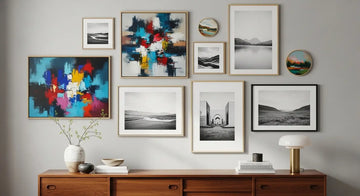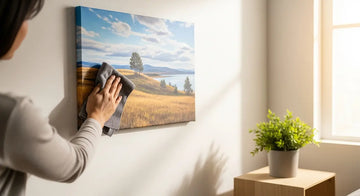Choosing the right canvas size can feel like both an art and a science. It's a decision that dramatically impacts how your artwork is perceived, how it integrates into a space, and ultimately, its overall visual impact. Whether you're an artist looking to bring your vision to life, a photographer showcasing a cherished memory, or a designer curating the perfect aesthetic for a room, understanding canvas dimensions is crucial. This comprehensive guide will walk you through everything you need to consider, ensuring your next canvas choice is the perfect fit.
The Foundation: Understanding Your Space
Before you even think about the artwork itself, the most critical step is to assess the environment where your canvas will live. A magnificent landscape painting might be overwhelming in a small nook, while a delicate portrait could get lost on a vast wall.
1. Wall Dimensions and Scale:
Start by measuring the wall where you intend to hang the canvas. Consider both the width and height. A good rule of thumb for single pieces is that the artwork should occupy about two-thirds to three-quarters of the available wall space. For example, if you have a 10-foot wide wall (120 inches), your canvas or arrangement should ideally span between 80 to 90 inches. This prevents the artwork from looking either dwarfed or crammed.
2. Furniture and Architectural Features:
Take into account any furniture directly below the hanging spot, such as a sofa, bed, or console table. The canvas should ideally be about two-thirds the width of the furniture it's above. Also, consider architectural elements like windows, doorways, shelves, or fireplaces. These can frame or define the space where your art will hang. Avoid placing a canvas that extends beyond the width of the furniture below it, as this can create an unbalanced look.
3. Room Function and Ambiance:
Think about the purpose of the room. A grand, oversized piece might be perfect for a dramatic living room or an entryway, creating an immediate focal point. For a more intimate space like a bedroom or a cozy reading nook, smaller or medium-sized canvases might be more appropriate, fostering a sense of calm and personal reflection. In a bustling office, a series of smaller, complementary pieces might work better than one large, imposing canvas.
The Heart of the Matter: Your Artwork's Subject and Style
Once you have a handle on your space, it's time to consider the artwork itself. The subject matter, style, and intricate details of your piece play a significant role in determining the optimal canvas size.
1. Subject Matter and Detail:
-
Intricate Details: If your artwork features fine details, delicate brushstrokes, or small text (though our Standard Matte Canvas is best for bold designs, as mentioned!), a larger canvas will allow these elements to be appreciated without straining the viewer's eyes. Think of detailed cityscapes, elaborate portraits, or complex still lifes.
-
Bold and Simple: For more abstract pieces, bold graphic designs, or minimalist art, you have more flexibility. A larger canvas can amplify the impact of a simple design, making a powerful statement. Conversely, a smaller canvas can still effectively convey the message of a bold, concise image.
-
Landscapes and Vistas: Landscapes often benefit from wider canvases (e.g., panoramic ratios) to capture the breadth and sweep of the scene. This allows the viewer's eye to travel across the vista, immersing them in the environment.
-
Portraits: For portraits, consider the emotional impact. A close-up portrait might feel more intimate on a medium-sized canvas, while a full-body portrait might require a taller, larger format to capture the subject's presence.
2. Style and Medium:
-
Abstract Art: Abstract pieces can shine in almost any size, often benefiting from larger canvases to allow the viewer to get lost in the forms and colors.
-
Photography: The resolution and quality of your photograph are paramount. Stretching a low-resolution image too large will result in a pixelated, unprofessional print. Always check your image resolution against the desired print size. A professional print shop can usually advise on maximum print sizes for your specific image file.
-
Graphic Design: For designs with clear lines and bold shapes, ensure the size allows for crispness without losing impact. Remember, for our Standard Matte Canvas, "Ideal for Simple Designs: Best suited for bold designs; avoid thin lines or small text" is a key consideration.
3. Emotional Impact:
How do you want the viewer to feel when they interact with your art?
-
Intimacy: Smaller canvases often create a more personal, intimate connection, drawing the viewer closer.
-
Grandeur/Statement: Larger canvases command attention, making a bold statement and often becoming the focal point of a room.
-
Dynamic: A series of canvases, or a diptych/triptych, can create a sense of movement and narrative.
Common Canvas Ratios and Their Applications
Understanding common canvas ratios can help you visualize how your artwork will fit within different dimensions.
-
Portrait (e.g., 16x20, 18x24): Taller than wide, ideal for human figures, specific architectural elements, or vertical landscapes like waterfalls or tall trees. Creates a sense of elegance and upward movement.
-
Landscape (e.g., 20x16, 24x18): Wider than tall, perfect for panoramic scenes, horizontal compositions, and group shots. Emphasizes breadth and space, often creating a calming effect.

Beyond a Single Canvas: Groupings and Galleries
Sometimes, one canvas isn't enough, or you want to create a dynamic display.
1. Diptychs and Triptychs:
These are artworks divided into two (diptych) or three (triptych) separate canvases that form a single cohesive image. They can add a contemporary flair and are great for breaking up large expanses of wall without using a single, monolithic piece. Ensure consistent spacing between the canvases for the best effect.
2. Gallery Walls:
A gallery wall is a curated collection of various-sized artworks, photographs, and sometimes even mirrors or decorative objects. This approach allows for immense creativity and personalization. When planning a gallery wall:
-
Start with a central piece: Choose one or two focal points.
-
Vary sizes and orientations: Mix squares, portraits, and landscapes.
-
Maintain a visual theme: This could be color palette, subject matter, frame style, or a combination.
-
Plan on the floor: Lay out your arrangement on the floor first to experiment with spacing and composition before hanging. Aim for consistent spacing (1-3 inches) between pieces for a cohesive look.

Practical Considerations for Your Canvas
Our Standard Matte Canvas offers excellent quality and features designed for durability and ease of display. Keep these practical aspects in mind when making your choice:
-
Poly-Cotton Canvas: Our durable and vibrant poly-cotton blend ensures your colors pop and your image lasts.
-
Scratch-Resistant UV Coating: This protective layer is crucial for maintaining the vibrancy and integrity of your artwork over time, especially in areas with direct sunlight.
-
1.25” Depth Frame: This provides a substantial, high-quality look, making your wall art stand out from the wall beautifully.
-
Sawtooth Hanging Hardware: Included hardware makes installation quick and effortless, saving you time and hassle.
-
"Ideal for Simple Designs: Best suited for bold designs; avoid thin lines or small text." This is a key feature of our Standard Matte Canvas. If your design has intricate details or small typography, consider if a different print medium might be more suitable, or embrace the bold clarity this canvas excels at.
Want to explore the variety of canvas options available to bring your vision to life? You can find a wide range of choices and sizes to suit your needs by visiting rezspirit.com/collections/canvas.
Important Note on Shipping: Be aware that "Matte Canvas of size higher than 16x24" cannot deliver to PO boxes. Shipment will fail if attempted and will return to sender." This is a crucial detail for planning your order and delivery address.
Final Tips for Success
-
Mock-up is Key: Before committing, create a mock-up. You can use painter's tape to outline the desired canvas size on your wall, cut out paper templates, or even use augmented reality apps on your phone to visualize the artwork in your space.
-
Consider the Viewpoint: Where will the viewer typically stand? Art in a hallway might be viewed while passing, whereas art above a sofa is often seen from a seated position.
-
Don't Fear Experimentation: Art is personal. While these guidelines are helpful, trust your instincts. If a particular size feels right for your vision, go for it!
Choosing the perfect canvas size is a thoughtful process that combines artistic vision with practical considerations. By taking into account your space, the nature of your artwork, and the various display options, you can ensure your canvas not only looks stunning but also perfectly enhances its environment. Our Standard Matte Canvas provides a reliable and beautiful foundation for bringing your art to life, ready to impress with its vibrant quality and sturdy construction.


